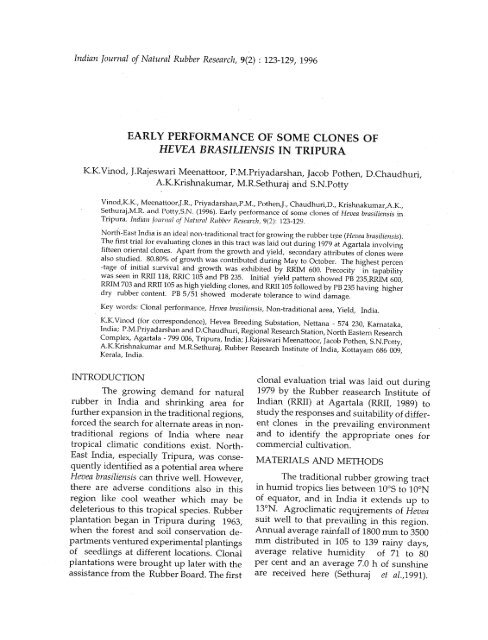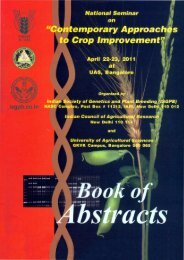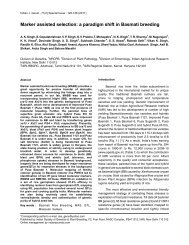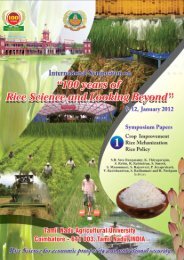HEVEA BRASILIENSIS IN TRIPURA
HEVEA BRASILIENSIS IN TRIPURA
HEVEA BRASILIENSIS IN TRIPURA
- No tags were found...
Create successful ePaper yourself
Turn your PDF publications into a flip-book with our unique Google optimized e-Paper software.
Indian Journal of Natural Ruober Research, 9(2) : 123-129, 1996EARLY PERFORMANCE OF SOME CLONES OF<strong>HEVEA</strong> <strong>BRASILIENSIS</strong> <strong>IN</strong> <strong>TRIPURA</strong>K.K.Vinod, J.Rajeswari Meenattoor, P.M.Priyadarshan, Jacob Pothen, D.Chaudhuri,A.K.Krishnakumar, M.R.Sethuraj and S.N.PottyVinod,K.K., Meenattoor,J.R., Priyadarshan,P.M., Pothen,J., Chaudhuri,D., Krishnakumar,A.K.,Sethuraj,M.R. and Potty,S.N. (1996). Early performance of some clones of Hevea brasiliensis inTripura. Indian foumal of Natural Rubber Research, 9(2): 123-129.North-East India is an ideal non-traditional tract for growing the rubber tr~e (Hevea brasiliensis).The first trial for evaluating clones in this tract was laid out during 1979 at Agartala involvingfifteen oriental clones. Apart from the growth and yield, secondary attributes of clones werealso studied. 80.80% of growth was contributed during May to October. The highest percen-tage of initial s:.~rvival and growth was exhibited by RRIM 600. Precocity in tapabilitywas seen in RRII 118, RRIC 105 and PB 235. Initial yield pattern showed PB 235,RR1M 600,RRJM 703 and RRII 105 as high yielding clones, and RRII 105 followed by PB 235 having higherdry rubber content. PB 5/51 showed moderate tolerance to wind damage.Key words: Clonal performance, Hevca brasiliensis, Non-traditional area, Yield, India.K.K.Vinod (for correspondence), Hevea Breeding Substation, Nettana - 574 230, Karnataka,India; P.M.Priyadarshan and D.Chaudhuri, Regional Research Station, North Eastern ResearchComplex, Agartala- 799 006, Tripura, India; J.Rajeswari Meenattoor, Jacob Pothen, S.N.Potty,A.K.Krishnakumar and M.R.Sethuraj, Rubber Research Institute of India, Kottayam 686 009,Kerala, India.<strong>IN</strong>TRODUCTIONThe growing demand for naturalrubber in India and shrinking area forfurther expansion in the traditional regions,forced the search for alternate areas in nontraditionalregions of India where neartropical climatic conditions exist. NorthEast India, especially Tripura, was consequentlyidentified as a potential area whereHevea brasiliensis can thrive well. However,there are ad verse conditions also in thisregion like cool weather which may bedeleterious to this tropical species. Rubberplantation began in Tripura during 1963,when the forest and soil conservation departmentsventured experimental plantingsof seedlings at different locations. Clonalplantations were brought up later with theassistance from the Rubber Board. The firstclonal evaluation trial was laid out during1979 by the Rubber reasearch Institute ofIndian (RRII) at Agartala (RRII, 1989) tostudy the responses and suitability of differentclones in the prevailing environmentand to identify the appropriate ones forcommercial cultivation.MATERIALS AND METHODSThe traditional rubber growing tractin humid tropics lies between 10°S to 10°Nof equator, and in India it extends up to13°N. Agroclimatic requjrements of Heveasuit well to that prevailing in this region.Annual average rainfall of 1800 mm to 3500mm distributed in 105 to 139 rainy days,average relative humidity of 71 to 80per cent and an average 7.0 h of sunshineare received here (Sethuraj et al.,1991).
0experiences0124V<strong>IN</strong>OD eta/.Tripura experiences warm humid climateexcept during winter when low temperatureprevails (Fig.1). Also, this0regionhailstorms and high velocitytropical winds along with pre-monsoonshowers.The trial consisted of fifteen orientalclones viz., RRII 5, RRII 105, RRII 118,RRII 203, RRIM 600, RRIM 605, RRIM 703,PB 5/51, PB 86, PB 235, RRIC 52, RRIC 105,GT 1, Gl 1 and Harbel 1 of Hevea brasiliensis(Willd. ex. Adr. de Juss.) Muell. Arg. Theexperiment was laid out at the regionalresearch farm of RRII at Taranagar, Agartala(23° 53' N; 91 o 15'E; 30m MSL) during July1979 with forty trees per clone planted at aspacing of Sm x Sm in a completelyrandomized design.The data on initial survival and earlygrowth were recorded for the first two yearsafter planting. The recording of girth datato monitor growth was done at quarterlyintervals i.e., during February, May, Augustand November every year. Bark thicknesswas recorded periodically. The progressivegrowth of clones was determined usingperiodic girth increment data and comparisonwas made between growth contributionduring winter and non-winter periods.A severe hailstorm experienced onApril3, 1986 inflicted considerable damageto the bark on one side of the trunk. Theresultant wound due to chipping of thebark took almost three years to heal but. remained rough and uneven (Meenattooret al.,1995). The undamaged side wasopened for tapping during July 1989. Aftera short gap of three months for initial flowstabilisation, yield was monitored regularlyfor three years by cup coagulation.Tapping on B0-1 panel was concludedduring October 1993. .Secondary characters like incidenceof wind damage, pattern of annual flower-.~~::I.cQl~a!Qla:.oi:SI!!::I1l!8.E{!100 r------_;,.-----, 400604020J F M A JJASON--- Min. Temp. C + Max.l'emp. C+ R H %300100(0625 hrs) -8- R H% (1225 hrs). • Av. Rainfall (mm) ~ No. of Rainy daysl'ig. I. Agrnmeteornlogical nH:,ln data nl ·l.n,magarfarm, Agartala (1982-1993)ing (Meenattoor et al.,1989) and winteringbehaviour of clones (Vinod et al., 1996 b)were also monitored. The data wereanalysed following standard statistical procedures.RESULTS AND DISCUSSIONSurvival and initial growthSurvival percentage of all the clonesexcept RRIM 703 and PB 5/51 was betterwith RRIM 600 having 92.5 per centsurvival followed by RRII 118, RRIC 105and Gl 1 (Table 1). RRIM 600 also showed
EARLY PERFORMANCE OF <strong>HEVEA</strong> <strong>IN</strong> <strong>TRIPURA</strong> 125Table 1. Plant survival average (plant) height andnumber of leaf whorls after one yearClone Survival Plant Number(%) height (em) of whorlsRRII 5 87.50 120.90 3.0RRII 105 82.50 102.87 2-9RRII 118 90.00 109.72 3.0RRII 203 87.50 110.74 2.9RRIM600 92.50 131.60 3.1RRIM605 77.50 97.02 2.9RRIM703 65.00 94.23 2.9RRIC 52 72.50 100.58 3.0RRIC 105 90.00 105.66 2.8PB 5/51 65.00 116.07 3.0PB 86 70.00 115.82 3.0PB 235 82.50 113.03 2.9GT 1 72.50 107.69 3.1Gil 90.00 118.11 3.2Harbel1 80.00 107.95 3.1SE 9.44 9.70 2.99better plant height (131.6 em) during thefirst year. RRIM 605 and RRIM 703 plantswere shorter than all other clones. Numberof leaf whorls was almost similar in all theclones.Girth and bark thicknessThe first nine years' growth dataindicated that on an average 19.20 per centof annual growth was contributed duringwinter half and the rest 80.80 per centresulted during non-winter half. The cloneswhich showed relatively more averagegrowth contribution during winter half areRRII 118, PB 235, PB 86, RRIC 105, RRJC 52and RRII 5.Growth as expressed by values ofabsolute girth at fifth year showed that afew clones were well comparable with thatat the Central Experiment Station, of RRJI atChethackal, Kerala which represents traditionalregion (Table 2). Ranking of clonesbased on absolute girth showed RRJI 118,RRJC 105, RRIM 605, GT 1, RRJI 203, RRIM600 and RRII 105 in the order of hierarchyduring fifth year and RRJC 105, RRIC 52,Table 2. Average girth of clones at 5'" and 13'h years after planting (YAP ), bark thickness at three yearsafter tapping and average growth contribution during summer and winterGirth (em) Uark Growth contribution .(%)Clone thickness5 YAP 13 YAP {mm) Winter Non-winterRRII 5 29.44 62.28 7.56 19.83 80.17RRII 105 32.78 (30.88) 68.70 7.95 19.02 80.98RRII 118 37.65 (32.18) 77.42 8.07 27.46 72.54RRII 203 33.91 74.09 8.32 18.89 81.11RRIM 600 33.48 (31.55) 72.09 7.94 17.01 83.00RRIM 605 35.54 70.47 7.43 15.28 84.73RRIM 703 32.12 (32.90) 64.28 8.09 17.17 82.84RRIC 52 31.90 79.68 8.27 20.15 79.85RRIC 105 37.15 81.70 8.29 22.18 77.83PB 5/51 30.91 62.26 5.72 14 .. 48 85.52PB 86 29.02 68.71 6.83 22.26 77.74PB 235 31.15 (29.72) 73.31 7.88 24.64 75.36GT 1 34.10 (27.79) 67.07 7.23 17.68 82.32Gil 28.66 (26.13) 57.29 7.30 15.94 84.07Harbell 29.05 58.35 6.95 16.02 83.99Mean 32.46 69.18 7.59 19.20 80.80• Values in parentheses show the absolute mean girth of the clones in the traditional region ( CES, Chethakal)at 5th YAP ( Sethuraj eta/., 1991).
126V<strong>IN</strong>OD et al.RRII 118, RRII 203, PB 235 , RRIM 600,RRIM 605, PB 86 and RRII 105 duringthirteenth year. Ranking had showri a significantcorrelation (0.668) between both theyears. Bark thickness recorded during fifthyear showed that clones with larger girthhad thicker bark.Tappability of clonesDuring seventh year after planting,three clones viz., RRII 118 (80.65%),RRIC 105 (77.78%) and PB 235 (70 %)attained tappable girth of 50 em and aboveat 125 em above bud union. By eighth year,as many as six clones had more than 70 percent trees ready for tapping and by ninthyear all clones except Gll and Barbell hadattained tappability. Even after 12 years allthe trees in these two clones had notreached tappability (Fig.2).Yielding pattemEven though most of the clones hadattained tappability before ninth year,1 2 3 . .. 5 6 7 8 9 10 11 12 13 14 150 6thyearCloneoEi[J 8th yeor - 101hyoerFig. 2. Percentage tappability ot clones .11 6, ll and 13year after planting (clones are numbered asgiven in Table 1)tapping was delayed owing to the restgiven to trees to recover from the serioushail damage during 1986. In fact, thedamage had caused prolongation of ges-Table 3. Dry rubber yield for fifteen clones during first three years of tappingCloneDry rubber yield (g/tree/tap)Projected mean1990-91 1991-92 1992-93 yield (kg/ha/yearRRII 5 22.05 28.28 24.60 672.63 ~fgRRII 105 32.75 30.79 37.28 1025.61 beRRII118 24.12 28.60 37.53 896.91 cdRRII 203 27.95 31.48 38.48 980.34 bedRRIM600 33.18 34.51 42.86 1153.22 bRRIM605 24.21 22.30 34.57 840.40 cdeRRIM703 27.24 30.14 42.11 1025.82 beRRIC 52 16.07 19.75 23.78 598.67 gRRIC 105 26.03 27.81 31.88 878.65 cdPB 5/51 21.44 20.54 24.43 673.24 efgPB 86 23.46 25.36 31.23 812.80 defPB 235 46.63 38.09 52.71 1396.26 aGT 1 17.78 20.19 23.79 625.33 fgGl 1 14.82 15.87 20.30 528.39 gHarbel1 15.03 20.20 21.93 560.10Mean 24.85 25.73 32.50 965.21SE(d) 3.63 3.10 3.07 64.50350 trees/ha; Means followed by same letters are not significantly different at 5% level by DMRT.
EARLY PERFORMANCE OF <strong>HEVEA</strong> <strong>IN</strong> <strong>TRIPURA</strong> 127tation period in all the clones (Meenattooret al., 1991). Initial average yield showed PB235 superior to all other clones (21.07%more than RRIM 600). RRIM 600 rankedsecond followed by RRIM 703 and RRII 105(Table 3). The high yielding character ofPB 235 was reported earlier in Malaysia(Thim and Chin,1986). Vinod et al., (1996a)reported that RRIM 703 was having betterstability in yield among high yielding clones.However, the stability in yield was found todecrease as yield potential goes up. Dryrubber content (drc) of selected clones weremonitored periodically and it was seen thatRRII 105 had highest drc in the initial yearsfollowed by PB 235 and RRIM 600. GT 1recorded lowest drc in all the years(Table 4).The yielding pattern of the clonesshowed a uniform trend which consisted ofa lagging phase and peaking phase. Thelagging phase included months from Juneto October and peaking phase consisted ofNovember and December. Yield remainedlow until October and peaked during Novemberand showed a fall thropgh Decemberand January. Remaining months weregenerally unproductive for they includedannual rest and period of yield stabilisation.The magnitude of peaking was high in highyielding clones and low in those whichyield low (Fig.3). Except for PB 235 whichshowed a gradual increase in yield trendover months, all the other clones behavedalmost uniformly. This feature of PB 235 ishighly desirable, because this clone canprovide sustainable yield during laggingphase as well. Besides, steep increase inyield during a short span of time observedin other clones might be detrimental in thelong run as it coincided with a stress period(low temperature and wintering). In theclones which showed fluctuating yield trend,the yield contribution during lagging phasewas about 40 per cent and that during peakingmonths was about 60 per cent. (Fig .4).Wind damageAll the clones suffered wind damageand details are given in table 5. UntilTable 4. Dry rubber content of ten selected clones during first three years of tappingCloneDry rubber content (w /w) %1990-91 1991-92 1992-93 MeanAveragerankRRII 105 32.7± 7.8 34.9± 5.7 37.8±4.5 35.11 aRRII 118 29.9± 3.6 29.7± 4.6 34.5±5.2 31.38 cRRII 203 29.5± 4.3 32.1± 7.2 32.4±6.1 31 .30 cRRIM 600 30.5± 5.0 32.8± 6.0 36.4±6.2 33.25 bRRIC 105 31.7± 3.4 32.3± 4.9 35.8±4.9 33.28 bPB 86 29.1± 5.3 30.8± 5.9 33.8±5.5 31.24 cPB 235 30.6± 3.5 33.3± 3.4 36.1±4.5 33.31 bGTl 27.0± 3.9 27.4± 2.5 30.1±4.1 28.19 dGil 27.9± 3.2 27.9± 5.4 32.1±4.5 29.29 dHarbell 29.2± 7.2 30.7± 5.3 35.6±3.6 31.24 beValues are followed by corresponding standard deviationMean values followed by same letters are not significant at P = 0.05 level by DMRTSpearman's rank correlation between years (* Significant at P = 0.05) :I year VS II year :0.879*; I year vs nr year : 0.770*; II year VS III year : 0.648** Significant at 5% level1.06.36.33.03.37.02.710.09.06.3
128V<strong>IN</strong>OD et al.i:7513).s 1s75- PB235- RAIM7tXlMedium yielders··~ -· RAIM600- ARIIa:x!-•- RRU105oL---~--~--~--~----L---~--~ ·- RRII118~ PB88Low yielders+ RRIC105- RRI5->- RRIM605October 1994, RRII 105 suffered 34.5 percent trunk damage followed by GT 1(24.32%). No trunk damage was foundin PB 5/51. RRII 203 had only 5.13 per centtrunk snap. Branch snap was maximumin RRIM 605 (24.32%) and RRII 118 (23.68%)owing to their tall upright branching andheavy canopy. The susceptibility of RRII105 to wind damage was reported earlier(Nazeer et al.,1986.) No branch damage wasfound in PB 86 and RRIC 105. All the clonessuffered hail damage equally.--3)45,sL~=~~c:::::::oL---~--~~~~~~~--~~JUN JUL AUG SEP OCT NOV DEC JAN-PB~1 + GT1 - ~ FRC52 -+-HARB1 --:GilFig. 3. Average yielding pattern of clonesTable 5. Percentage of trees damaged by wind (uptoOctober, 1994)Clone Trunk sna£ Branch sna£RRII 5 11.42 5.71RRII 105 34.48 13.79RRII118 15.79 23.68RRII 203 5.13 10.26RRIM 600 15.79 7.89RRIM 605 8.11 24.32RRIM 703 8.57 5.71RRIC 52 17.24 6.89RRIC 105 14.28 0.00PB 5/51 0.00 2.63PB 86 10.26 0.00PB 235 16.22 16.22GT 1 24.32 16.22Gil 7.50 2.50Harbel 1 7.69 7.69RAIM703PB&51PB 86 t~~-\\~:~~~\\·\\\ \\0§\~\]RRIC100GT1Gl1 t; :.:;:~f\'E-\\·:;~~FIH 1 ~-:;~~\;;~;:~,\\\: '- ·:,~\\\\\\\\\\\\\\ ···--100 00 60II40I20- Non-winter . - W11terPeroentageFi12;. 4. Percentage yield contribution during winterand non-winter monthsI0
EARLY PERFORMANCE OF <strong>HEVEA</strong> <strong>IN</strong> <strong>TRIPURA</strong> 129CONCLUSIONClonal performance, in general, showsthat not all high yielding clones are suitablefor extensive cultivation. Among high yieldingclones, RRIM 600 had better initialsurvival, wide adaptation in initial growth(Meenattoor et al., 1991) and higher dryrubber content. RRII 105 was better in dryrubber content but was very prone to winddamage. PB 235 was relatively better thanall other clones in· initial survival, ada pta- ·tion during winter period, precocity inyielding, high dry rubber content and goodseasonal yield contribution but had moderatewind damage. RRII 703 had poor initialsurvival but had less wind damage. Theresults so far makes it difficult to name anideal clone for this region, but provides anidea about the initial performance of clones.An ideal clone for this region would be onehaving high yield, stability, better performanceof growth and yield during bothwinter and non-winter periods, wind resistanceand tolerance to Oidium heveaeinfection.ACKNOWLEDGEMENTAuthors acknowledge the contributionof the staff of Regional Research Station,Agartala for proper maintenance ofthe trial.REFERENCESMeenattoor,J.R., Krishnakumar,A.K., Sinha,R.R. andPotty,S.N. (1989). Flowering pattern of Heveaclones in Tripura. Indian Journal of NaturalRubber Research, 2 (2) : 139-142.Meenattoor,J.R., Vinod,K.K., Krishnakumar,A.K.,Sethuraj,M.R., Potty,S.N and Sinha,R.R..(1991).Clone x Envirmunent interaction during earlygrowth phase of Hevea brasiliensis: 1. Clonalstability on girth. Indian Journal of NaturalRubber Research, 4 (1): 51-54.Meenattoor, J.R., Vinod, K.K., Krishnakumar, A.K.,Potty, S.N., Sethuraj, M.R. and Pothen,J.(1995). Hailstorm damage to Hevea trees inTripura and the performance of the recoveredtrees. Indian Journal of Natural Rubber Research 18 (1): 51-53.Nazeer,M.A., Markose,V.C., George, P.J. and Panikkar,A.O.N. (1986).Performance of a few Heveaclones from RRII 100 series in large scale trial.Journal of Plantation Crops, 14: 99-104.RRII (1987). Annual report 1986-87. Rubber ResearchInstitute of India, Kottayam, pp. 90-95.RRII (1989) Annual report 1987- 88. Rubber ResearchInstitute of India, Kottayam.Sethuraj,M.R., Potty,S.N., Vijayakumar,K.R.,Krishnakumar,A.K., Rao,P.S., Thapliyai,A.P.,Krishna,T.M., Rao,G.G., Chaudhuri,D.,George,M.J., Soman,T.A. and Meenattoor, J.R.(1991). Growth performance of Hevea in thenon-traditional regions of India. Proceedings ofRubber Growers' Conference, 1989, Malacca,Malaysia, Rubber Research Institute of Malaysia,pp. 212-227.Thim,L.T. and Chin,P.T. (1986). Clonal block plantingtrial. Proceedings of RRIM Rubber Growers'Conference, 1986, Perak, Malaysia, Rubber ResearchInstitute of Malaysia, pp. 187-199.Vinod,K.K.., Meenattoor,J.R., Krishnakumar,A.K.,Pothen,J., Potty,S.N., and Sethuraj,M.R. (1996a).Clonal selection combining yield and stabilityin Hevea brasiliensis Muell. Arg. Joumal ofPlantation Crops, 24 (Supplement):458-463.Vinod,K.K., Meenattoor,J.R., Pothen,J., Krishnakumar,A.K.and Sethuraj,M.R.. (1996b). Performanceanalysis of wintering pattern in rubber(Hevea brasiliensis Muell. Arg.) clones. IndianJournal of Natural Rubber Research, 9: 44-47.





